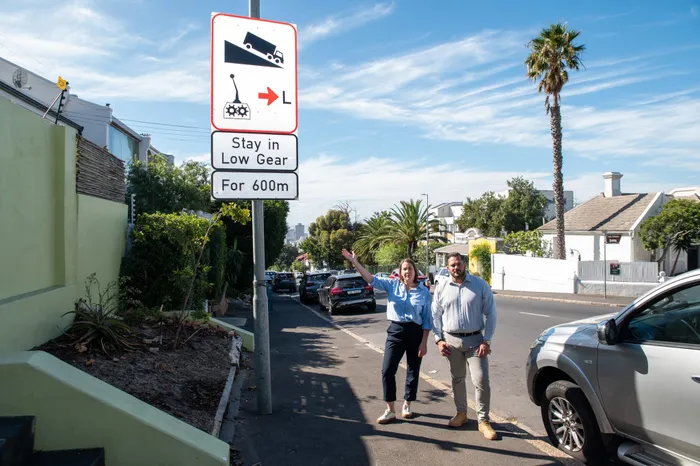
The City’s Transport Planning and Network Management team together with mayco member for Urban Mobility, Rob Quintas and ward councillor, Francine Higham, visit the site to technically assess the feasibility of arrestor structures.
Image: City of Cape Town/Supplied
A feasibility study is under way to mitigate erring vehicles along Kloof Nek Road.
The road has become notorious for the high number of accidents which take place along the route.
Over a three-year period, more than 365 vehicle-related crashes involving 722 drivers were recorded, which has raised concerns for additional safety measures and a call for drivers to ensure their vehicles are roadworthy.
Among the major incidents was a tour bus that collided with two vehicles and a wall on Kloof Nek Road in October, while a month prior a cement truck appeared to lose control on Kloof Nek Road, colliding with at least 17 cars before slamming into a wall.
The City’s Urban Mobility Directorate announced it is working on implementing measures to assist in mitigating the impact of errant vehicles travelling down Kloof Nek Road.
The City said it is in the process of completing the feasibility study on the implementation of arrestor structures at strategically located places along the road.
In the meantime, 18 Stay-in-Low-Gear warning signs have been erected to caution truck drivers in particular.
Mayco member for Urban Mobility, Rob Quintas said: “Kloof Nek Road is a Class 2 Major Arterial route, meaning it is an important access route that carries large volumes of traffic. Despite numerous requests, the City cannot restrict heavy vehicles given the functional classification of the road, and due to the fact that there are a limited number of access roads to and from the CBD area to the Camps Bay area and beyond,” he said.
The City said the speed limit along Kloof Nek Road is 50km/h in both directions.
A recent investigation found the average speed for heavy vehicles was 51km/h northbound (downhill); and 47km/h southbound; and for light vehicles it was 57km/h northbound and 56km/h southbound.
The City said the investigation found that the majority of road users do not exceed the speed limit, however, there were isolated instances of speeding.
Quintas added: “At certain locations along Kloof Nek Road the gradient is as steep as 14%. It is the responsibility of each motorist to watch their speed and to ensure that their vehicle is roadworthy.
“By adhering to the new signs as well as ensuring your vehicle is fit to be on the road you can ensure your safety, as well as the safety of other road users on the road. We can significantly improve road safety if we all play our part, adhere to the speed limit and be cautious,” said Quintas.
Meanwhile, after 18 months, the Tafelberg Road rehabilitation project has been completed, providing access to the popular Table Mountain National Park and the Table Mountain aerial cableway.
Ward councillor Francine Higham said: "I encourage our residents and visitors to do this walk and appreciate the amazing work that has been done here. It is a significant upgrade and it provides safer access for pedestrians all the way from Kloof Nek Road right up to the cableway."
The upgrades include a resurfaced road, wider verges, extended boardwalks, formalised paved parking areas and sidewalks, and an upgraded stormwater system that has retaining walls, gabions and infrastructure to assist with channelling runoff from rainfall events away from the road.
Cape Argus
Related Topics:
